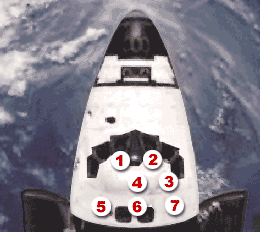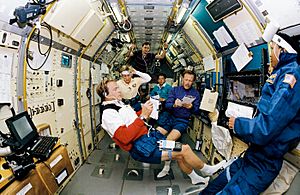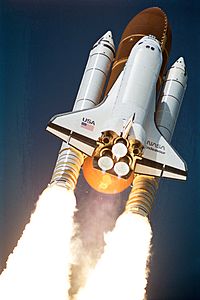STS-47 facts for kids
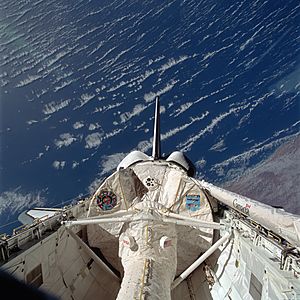
Spacelab Module LM2 in Endeavour's payload bay, serving as the Spacelab-J laboratory.
|
|
| Mission type | Microgravity research |
|---|---|
| Operator | NASA |
| Mission duration | 7 days, 22 hours, 30 minutes, 24 seconds |
| Distance travelled | 5,265,523 km (3,271,844 mi) |
| Orbits completed | 126 |
| Spacecraft properties | |
| Spacecraft | Space Shuttle Endeavour |
| Launch mass | 117,335 kg (258,679 lb) |
| Landing mass | 99,450 kg (219,250 lb) |
| Payload mass | 12,485 kg (27,525 lb) |
| Crew | |
| Crew size | 7 |
| Members |
|
| Start of mission | |
| Launch date | 12 September 1992, 14:23:00 UTC |
| Launch site | Kennedy Space Center, LC-39B |
| Contractor | Rockwell International |
| End of mission | |
| Landing date | 20 September 1992, 12:53:24 UTC |
| Landing site | Kennedy Space Center, SLF Runway 33 |
| Orbital parameters | |
| Reference system | Geocentric orbit |
| Regime | Low Earth orbit |
| Perigee | 297 km (185 mi) |
| Apogee | 310 km (190 mi) |
| Inclination | 57.02° |
| Period | 90.00 minutes |
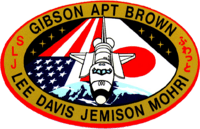 STS-47 mission patch  Back row: N. Jan Davis, Mark C. Lee, Robert L. Gibson, Mae C. Jemison, Mamoru Mohri Front row: Jerome "Jay" Apt, Curtis L. Brown Jr. |
|
STS-47 was the 50th NASA Space Shuttle mission. It was also the second flight for the Space Shuttle Endeavour. The main goal of the mission was to do science experiments in a special lab called Spacelab-J. This lab was built inside the shuttle's cargo area. It was a team effort between NASA and the National Space Development Agency of Japan (NASDA).
This mission had some amazing "firsts" among its crew. Mamoru Mohri was the first Japanese astronaut to fly on the shuttle. Mae C. Jemison became the first African-American woman to travel to space. Also, Mark C. Lee and N. Jan Davis were the only married couple to fly together on a shuttle mission. This was unusual because NASA usually tried to avoid assigning married couples to the same flight.
Contents
Meet the Crew
The STS-47 mission had a crew of seven astronauts. They worked together to complete all the science experiments in space.
| Position | Crew Member | |
|---|---|---|
| Commander | Fourth spaceflight |
|
| Pilot | First spaceflight |
|
| Mission Specialist 1 | Second spaceflight |
|
| Mission Specialist 2 | Second spaceflight |
|
| Mission Specialist 3 | First spaceflight |
|
| Mission Specialist 4 | Only spaceflight |
|
| Payload Specialist 1 | First spaceflight |
|
Backup Crew Members
Sometimes, astronauts are trained as backups in case a main crew member cannot fly. Here are the backup crew members for STS-47:
| Position | Astronaut | |
|---|---|---|
| Payload Specialist 1 or 2 | First spaceflight |
|
| Payload Specialist 1 or 2 | First spaceflight |
|
| Payload Specialist 1 | First spaceflight |
|
Where Did They Sit?
The astronauts had specific seats for launch and landing. Some seats were on the Flight Deck, and others were on the Middeck.
| Seat | Launch | Landing | |
|---|---|---|---|
| S1 | Gibson | Gibson | |
| S2 | Brown | Brown | |
| S3 | Lee | Davis | |
| S4 | Apt | Apt | |
| S5 | Davis | Lee | |
| S6 | Jemison | Jemison | |
| S7 | Mohri | Mohri |
NASA had an unwritten rule about married couples flying together. They usually tried to avoid it. However, when NASA found out that Mark Lee and Jan Davis were married, they decided to let them stay on the mission. This was because both astronauts had very important jobs for the flight.
Mission Highlights

STS-47 launched on September 12, 1992, at 10:23 a.m. EDT. It launched from Pad 39B at Kennedy Space Center. This was the first time a shuttle mission launched exactly on time since 1985.
The main part of the mission was the Spacelab-J laboratory. This was a joint project between NASA and Japan's NASDA space agency. Inside Spacelab-J, the crew did many microgravity experiments. Microgravity means a very low level of gravity, like what astronauts feel in space. These experiments focused on materials and life sciences.
The crew worked in two teams, called the "red team" and "blue team." They took turns working 12-hour shifts to keep the experiments going all day and night. Brown, Lee, and Mohri were on the red team. Apt, Davis, and Jemison were on the blue team. Commander Gibson could work with both teams.
Spacelab-J had 24 experiments about materials and 20 experiments about life sciences. Most of these were sponsored by NASA and NASDA. Two experiments were from other groups. A person named Homer Hickam helped the crew from the ground. He talked to them about their experiments and shared questions from scientists.
What Did They Study?
The materials science experiments looked at many things. These included biotechnology, electronic materials, and how liquids move in space. They also studied glass, ceramics, metals, and alloys.
The life sciences experiments focused on human health in space. They also studied cells, how living things develop, and how space affects animals and humans. They looked at space radiation and daily body rhythms.
The experiments used many different living things. These included the astronauts themselves, Japanese koi fish, plant cells, chicken embryos, fruit flies, fungi, plant seeds, frogs, frog eggs, and oriental hornets.
Other Experiments
The shuttle also carried other experiments. These were done in the middle section of the shuttle. They included:
- The Israel Space Agency Investigation About Hornets (ISAIAH)
- The Solid Surface Combustion Experiment (SSCE)
- The Shuttle Amateur Radio Experiment (SAREX II)
There were also experiments done outside the shuttle. These used the Ultraviolet Plume Imager (UVPI) and observations from the Air Force Maui Optical Station (AMOS).
The hornet experiment (ISAIAH) was the first space experiment for the Israel Space Agency. Scientists wanted to see how oriental hornets would build their nests in space. Unfortunately, a problem with the water system caused the humidity to rise. This led to most of the hornets and their pupae dying. No new nests were built in space. The hornets that survived lived much shorter lives than hornets on Earth.
Twelve special containers called Get Away Special (GAS) canisters were in the shuttle's cargo bay. Ten of these had experiments inside. One of these, G-102, was special. It was sponsored by the Boy Scouts of America's Exploring Division. This was the first space experiment made entirely by Boy Scouts!
Two other experiments came from the Ashford School of Art & Design in the United Kingdom. This was a girls-only school at the time. They had won a competition. One experiment created a "chemical garden" in space. The growths spread out in strange ways, twisting and forming spirals. The other experiment did not work correctly. After the mission, the chemical garden experiment was shown at the London Science Museum.
During the mission, astronaut Mae Jemison spoke live from space to students in Chicago. This event was held at the Chicago Museum of Science and Industry.
The mission was supposed to last until September 19, 1992. But it was extended for one more day. This allowed the crew to finish some important experiments.
Gallery
-
Eye of Hurricane Bonnie (1992) photographed onboard Endeavour.


